
EEG is a short way to say electroencephalogram. It is a test that gives doctors important information about your brain. We do routine EEG, sleep deprived EEG, prolonged/Long-Term monitoring EEG depending on your doctor’s request.
Long-Term Monitoring is a similar test-except it includes a video recording that gives your doctor more information about your brain. Sometimes the camera is in the ceiling, and sometimes it’s on the EEG machine. An EEG technologist will talk to you about what you need to know about the EEG procedure.



Is your child scheduled to have a routine electroencephalogram (EEG), sleep deprived EEG or long-term EEG monitoring at Children’s Medical Center?
The tests record brain-wave patterns to determine if the children are having seizures or other problems. During Long-term Monitoring EEG the patient is monitored so that doctors, nurses and technologists can see what happens before, during and after abnormal brain wave activity. A long-term Monitoring might require an in-patient stay. This brief will help you talk to your child about the test. When children know what to expect, they feel less anxious, are more willing to cooperate and have less difficulty before and after the experience.
What does your child need to know about the procedure? That depends on the child’s age. Tell toddlers and preschoolers one to three days before the appointment. Inform school-age children a week before hand. That gives them time to think about what you’ve said and to ask questions. Remind children that they won’t be alone during the procedure.
Herein we discuss the process to aid you prepare your child for an EEG. If you have questions about preparing your child for the test or having questions about your child’s neurology care, call us and speak directly with our EEG Technologist.

Electrodes will be put on the child’s head to pick brain electrical activity. This brain electrical activity is then displayed as brain waves with the help of a computer. Brain waves are the messages from your brain that tell your body what to do. The electrodes won’t hurt, and neither will the test. It only requires the patient to follow instructions and stay calm.
Before your EEG or Long-term monitoring EEG we shall locate where to put electrodes on your head. Next a small portion of lotion is rubbed on your head to ensure that the scalp is clean. This helps electrodes work better. We use paste to attach the electrodes to your head. You are encouraged to hold your head in one position for a while. This aids us finish the test as quickly as possible. Your Doctor will decide how long you will need to wear the electrodes. The test might take up to one to four hours depending on the kind of EEG requested by your doctor. A video might be used to monitor you while you are wearing the electrodes. The videos tell your doctor important things about how your brain is working. Sometimes, we’ll ask you to look at a blinking light or breathe in and out heavily. When your EEG test is done, then the electrodes are taken off gently and your head be cleaned.
EEGs are safe and painless.
Sometimes children need long-term EEG monitoring test. Then you might need to stay at CMC for few hours. The parent will have to stay with the patient. You might be monitored by a camera placed on the Monitoring machine to tell your doctor important things about how your brain is working. When your EEG is over, the doctor will interpret and share the report with the Patient/ guardian.
It just takes a few minutes to sign up and get fast, easy access to care, 24/7.